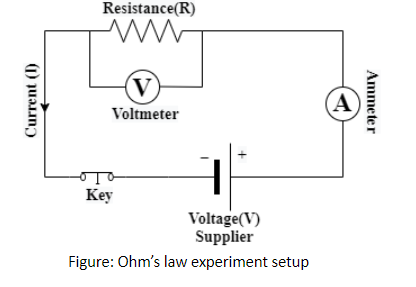
Draw a labeled diagram of the experiment explaining Ohm's Law.
Answer
577.2k+ views
Hint: Ohm’s law provides the relationship between supplied voltage and flow of current through a circuit that has some amount of resistance.
Complete step by step solution:
Ohm’s law states that the current flowing through a conductor between two points is directly proportional to the voltage across those two points. Mathematically:
$I = \dfrac{V}{R}$
Where,
$I$ denote the amount of current flowing,
$V$ denotes the amount of voltage applied,
$R$ is the resistance of the conductor.

Explanation:
Here, the closed-circuit has a power source (battery) which is supplying a voltage $V$. There is a Resistor of resistance $R$ at the other end of the circuit. When the key is closed a steady current $I$ flows through the circuit. There is an ammeter $A$ connected in series with the circuit to measure the amount of current flowing through the resistor. There is also a voltmeter $V$ connected parallel across the resistor to measure the potential difference across it.
Now, as this circuit obeys Ohm’s law, you’ll get the relationship as $V = I.R$.
To verify it through an experiment, you have to vary the voltage $V$ in regular intervals and take the corresponding values of current in the circuit.
Now, if you plot the data points in a graph paper keeping Voltage values ($V$) in the y-axis and current values($I$) in the x-axis then you will get a straight line connecting those data points. This straight line will have a slope the same as $R$.
Hence, Ohm’s law will be verified by a simple experiment.
Note:
Here, all the components are assumed to be ideal i.e. all including the battery, wires, and ammeter have zero internal resistance where the voltmeter has infinite resistance so that no current passes through it. In practice, nothing is ideal. So, we can verify Ohm’s law only within some error limits.
Complete step by step solution:
Ohm’s law states that the current flowing through a conductor between two points is directly proportional to the voltage across those two points. Mathematically:
$I = \dfrac{V}{R}$
Where,
$I$ denote the amount of current flowing,
$V$ denotes the amount of voltage applied,
$R$ is the resistance of the conductor.

Explanation:
Here, the closed-circuit has a power source (battery) which is supplying a voltage $V$. There is a Resistor of resistance $R$ at the other end of the circuit. When the key is closed a steady current $I$ flows through the circuit. There is an ammeter $A$ connected in series with the circuit to measure the amount of current flowing through the resistor. There is also a voltmeter $V$ connected parallel across the resistor to measure the potential difference across it.
Now, as this circuit obeys Ohm’s law, you’ll get the relationship as $V = I.R$.
To verify it through an experiment, you have to vary the voltage $V$ in regular intervals and take the corresponding values of current in the circuit.
Now, if you plot the data points in a graph paper keeping Voltage values ($V$) in the y-axis and current values($I$) in the x-axis then you will get a straight line connecting those data points. This straight line will have a slope the same as $R$.
Hence, Ohm’s law will be verified by a simple experiment.
Note:
Here, all the components are assumed to be ideal i.e. all including the battery, wires, and ammeter have zero internal resistance where the voltmeter has infinite resistance so that no current passes through it. In practice, nothing is ideal. So, we can verify Ohm’s law only within some error limits.
Recently Updated Pages
Master Class 10 General Knowledge: Engaging Questions & Answers for Success

Master Class 10 Science: Engaging Questions & Answers for Success

Master Class 10 Social Science: Engaging Questions & Answers for Success

Master Class 10 Maths: Engaging Questions & Answers for Success

Master Class 10 English: Engaging Questions & Answers for Success

Master Class 10 Computer Science: Engaging Questions & Answers for Success

Trending doubts
Why is there a time difference of about 5 hours between class 10 social science CBSE

Write a letter to the principal requesting him to grant class 10 english CBSE

What is the median of the first 10 natural numbers class 10 maths CBSE

The Equation xxx + 2 is Satisfied when x is Equal to Class 10 Maths

Which of the following does not have a fundamental class 10 physics CBSE

State and prove converse of BPT Basic Proportionality class 10 maths CBSE




